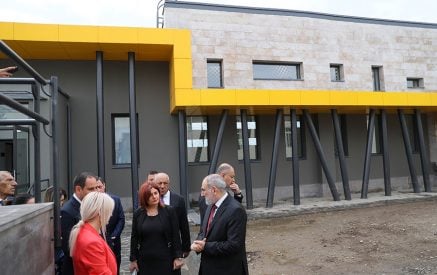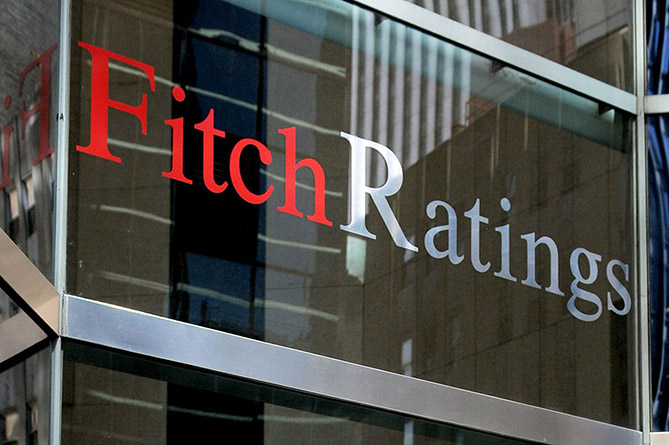Fitch Ratings – London – 03 Apr 2020: Fitch Ratings has revised the Outlook on Armenia’s Long-Term Issuer Default Ratings (IDR) to Negative from Stable and affirmed the IDRs at ‘BB-‘.
KEY RATING DRIVERS
The revision of the Outlook reflects the following key rating drivers and their relative weights:
MEDIUM
Read also
The coronavirus shock negatively affects the Armenian economy due to its exposures to commodities (a majority of exports), the Russian economy (for remittances, trade and FDI) and to tourism, only partially offset by the benefit of a lower oil price. This is in the context of Armenia’s relatively high net external debt and structural current account deficit, which is only partly financed by non-debt creating capital inflows. Despite a robust macroeconomic policy framework and continuing commitment to reform, the economic shock has put public debt on a markedly higher trajectory, and there are downside risks to our forecasts should the COVID-19 outbreak not be contained in 2H20 in line with Fitch’s current baseline assumption.
We forecast the coronavirus shock will drag down GDP growth from 7.6% in 2019 to 0.5% this year (a 4.4pp downward revision since our last review six months ago). Growth accelerated in 2H19 to 7.9%, and momentum remained strong in 2M20, providing some offset to the sharp contraction expected in 2Q20. The government has announced a state of emergency, with a support package totalling 2.3% of GDP, and the central bank has cut interest rates by 25bp to 5.25% following a fall in inflation to an average -0.1% in the first two months of 2020.
Fitch projects that GDP growth partially recovers in 2021, to 5.5%, supported by a rebound in external demand, investment catch-up, and revival of private consumption and employment growth, with a moderate drag from fiscal tightening. However, in line with our global macro-economic forecasts, the pace of recovery will be highly dependent on the path of the health crisis and the extent to which the coronavirus outbreak can be contained in 2H20. If a second wave of infections materialises and lockdown measures have to be re-introduced, our economic and fiscal forecasts for Armenia could be subject to material negative adjustment.
Fiscal stimulus and weak growth will push out this year’s general government deficit to a forecast 5.0% of GDP in 2020, up from 1.0% in 2019. The government’s coronavirus stimulus package has a focus on social support, subsidised lending, and loan refinancing and risk-sharing, with a high degree of uncertainty over how much will ultimately fall on the government balance sheet. Fitch anticipates additional fiscal measures including to directly support employment, partly offset by under-execution on capital projects and some reprioritisation of non-essential recurrent spending this year. We forecast the general government deficit will narrow to 3.5% of GDP in 2021, on the back of stronger GDP growth and a partial unwinding of support measures, underpinned by the government’s strong commitment to its medium-term fiscal targets.
General government debt is projected to rise from 53.6% at end-2019 to 59.2% of GDP in 2020 before falling back to 56.0% in 2021, upward revisions of 9.4pp and 7.4pp, respectively, since our last review, and well above the current ‘BB’ median of 46.5%. We assume some drawdown on central government deposits this year (by 0.8pp to 5.0% of GDP), use of budget support available under Armenia’s IMF precautionary Stand-By Arrangement, and domestic debt issuances. A high share of government debt is foreign currency-denominated (79% versus the ‘BB’ median of 56%) giving rise to exchange rate risk.
The coronavirus shock has increased external risks to the Armenian economy. Fitch forecasts the current account deficit remains high, at 8.5% of GDP in 2020 and 8.1% in 2021, compared with the 2018-2019 average of 8.8% and the current ‘BB’ median of 2.9%. Allowing for statistical discrepancies, the actual deficit could be closer to 5% of GDP, but only around a third of this is covered by non-debt creating capital inflows. The current account will be negatively affected this year by a collapse in tourism (which contributed 0.7pp to last year’s balance), the fall in prices of commodities and lower remittances from Russia. We expect this to be largely offset by import compression and lower energy costs. Fitch forecasts that net external debt will increase to 52.9% of GDP in 2021 from 46.7% in 2019, well above the ‘BB’ median of 19.4%, and the relatively high bank deposit dollarization ratio, at 52%, adds to risks.
Armenia’s ‘BB-‘ IDRs also reflect the following key rating drivers:
Armenia’s institutions have facilitated a peaceful and orderly political transition, and preserved macroeconomic and financial stability through a period of external volatility and domestic political shocks. Governance indicators are moderately above the peer group median, and there is a credible reform agenda and commitment to fiscal targets, also underpinned by the IMF Stand-By Arrangement. Set against these factors are Armenia’s lower income per capita, weaker external finances and higher general government debt than ‘BB’ medians. Armenia also has a high reliance on Russia, borders are closed with two neighbours, and the long-standing conflict with Azerbaijan over Nagorno-Karabakh has the potential to escalate.
An increase in foreign exchange reserves, and the availability of IFI financing mitigate near-term balance of payments risks. FX reserves have increased to 4.4 months of current external payments, from 3.5 months at end-2018, and in line with the ‘BB’ median. Fitch expects May’s IMF programme benchmarks will be met, with up to USD0.2 billion of budget support available in 2H20, in addition to which Armenia has USD1.3 billion of undisbursed IFI project financing in place. These external buffers have helped limit currency pressures, with the dram depreciating only 4% against the US dollar over the last month.
Fitch anticipates broad continuity in macroeconomic policy, and a quickening of structural reform from next year, building on efforts to tackle corruption and strengthen institutions and public financial management. The government’s Medium-Term Expenditure Framework targets a 2.2% of GDP increase in capex (to 5% of GDP) in line with a more growth-enhancing expenditure mix, and the government lowered corporate tax and introduced a flat income tax rate this year. The initial coronavirus response has been designed with a view to also limiting negative impacts on the government’s tax compliance drive. These factors underpin our forecast of a post-coronavirus fiscal adjustment. Under our longer-term debt projections, which assume average GDP growth of 4.1% from 2020-2029 (close to the current ‘BB’ median) and a 0.8pp improvement in the primary surplus, general government debt declines steadily to 47% of GDP in 2029.
Banking sector fundamentals will weaken as a result of the coronavirus shock, captured by the negative banking sector outlook for 2020. Fitch anticipates a marked worsening in asset quality, although regulatory forbearance should help banks manage NPL and capital metrics and avoid statutory limit breaches. At end-February, the sector NPL ratio was 5.7% and Tier 1 capital ratio 15.2% (but unevenly distributed within the sector). Profitability is lower than in similarly rated peers and is expected to come under pressure due to weaker economic growth and higher risk costs. Government subsidies and co-financing under the coronavirus response package will help support the supply of credit this year. Bank deposits grew 12.2% last year and so far we do not observe sizable outflows as a result of stressed market conditions.
ESG – Governance: Armenia has an ESG Relevance Score of 5 for both Political Stability and Rights and for the Rule of Law, Institutional and Regulatory Quality and Control of Corruption, as is the case for all sovereigns. These scores reflect the high weight that the World Bank Governance Indicators (WBGI) have in our proprietary Sovereign Rating Model. Armenia has a medium WBGI ranking at the 46th percentile (an improvement from 42nd in 2017), reflecting a recent track record of peaceful political transitions, a moderate level of rights for participation in the political process, moderate institutional capacity, established rule of law and a moderate level of corruption.
SOVEREIGN RATING MODEL (SRM) AND QUALITATIVE OVERLAY (QO)
Fitch’s proprietary SRM assigns Armenia a score equivalent to a rating of ‘BB-‘ on the LTFC IDR scale.
Fitch’s sovereign rating committee did not adjust the output from the SRM to arrive at the final LTFC IDR.
Fitch’s SRM is the agency’s proprietary multiple regression rating model that employs 18 variables based on three-year centred averages, including one year of forecasts, to produce a score equivalent to a LTFC IDR. Fitch’s QO is a forward-looking qualitative framework designed to allow for adjustment to the SRM output to assign the final rating, reflecting factors within our criteria that are not fully quantifiable and/or not fully reflected in the SRM.
RATING SENSITIVITIES
The main factors that could, individually or collectively, lead to negative rating action/downgrade are:
– A worsening of external imbalances, potentially evidenced by higher net external debt or current account deficits, or the recurrence of external financing pressures leading to a fall in reserves and a rise in the interest burden.
– Failure to put government debt/GDP on a downward trajectory over the medium term, for example due to a structural fiscal loosening or weaker GDP growth prospects
The main factors that could, individually or collectively, lead to positive rating action/upgrade are:
– A sustained improvement in external indicators, for example lower net external debt, a narrower current account deficit or improved FDI inflows.
– General government debt/GDP returning to a firm downward path over the medium term, for example due to a post-coronavirus-shock fiscal consolidation.
– Further improvement of structural indicators such as governance standards, leading to convergence towards the ‘BB’ peer median.
BEST/WORST CASE RATING SCENARIO
Ratings of Public Finance issuers have a best-case rating upgrade scenario (defined as the 99th percentile of rating transitions, measured in a positive direction) of three notches over a three-year rating horizon; and a worst-case rating downgrade scenario (defined as the 99th percentile of rating transitions, measured in a negative direction) of three notches over three years. The complete span of best- and worst-case scenario credit ratings for all rating categories ranges from ‘AAA’ to ‘D’. Best- and worst-case scenario credit ratings are based on historical performance. For more information about the methodology used to determine sector-specific best- and worst-case scenario credit ratings https://www.fitchratings.com/site/re/10111579.
KEY ASSUMPTIONS
Fitch assumes that Armenia will continue to experience broad social and political stability and that there will be no prolonged escalation in the conflict with Azerbaijan over Nagorno-Karabakh to a level that would affect economic and financial stability.
Fitch expects macroeconomic indicators to move in line Fitch’s Global Economic Outlook forecasts, but acknowledges that these are likely to be subject to frequent and possibly significant downward revisions given the evolving nature of the global crisis.
REFERENCES FOR SUBSTANTIALLY MATERIAL SOURCE CITED AS KEY DRIVER OF RATING
The principal sources of information used in the analysis are described in the Applicable Criteria.
ESG CONSIDERATIONS
Armenia has an ESG Relevance Score of 5 for Political Stability and Rights as World Bank Governance Indicators have the highest weight in Fitch’s SRM and are highly relevant to the rating and a key rating driver with a high weight.
Armenia has an ESG Relevance Score of 5 for Rule of Law, Institutional & Regulatory Quality and Control of Corruption as World Bank Governance Indicators have the highest weight in Fitch’s SRM and are therefore highly relevant to the rating and are a key rating driver with a high weight.
Armenia has an ESG Relevance Score of 4 for Human Rights and Political Freedoms as strong social stability and voice and accountability are reflected in the World Bank Governance Indicators that have the highest weight in the SRM. They are relevant to the rating and a rating driver.
Armenia has an ESG Relevance Score of 4 for Creditor Rights as willingness to service and repay debt is relevant to the rating and is a rating driver for Armenia, as for all sovereigns.
Additional information is available on www.fitchratings.com
APPLICABLE CRITERIA
APPLICABLE MODELS
Numbers in parentheses accompanying applicable model(s) contain hyperlinks to criteria providing description of model(s).
- Country Ceiling Model, v1.7.1 (1)
- Debt Dynamics Model, v1.2.0 (1)
- Macro-Prudential Indicator Model, v1.4.0 (1)
- Sovereign Rating Model, v3.11.0 (1)
ADDITIONAL DISCLOSURES
Fitch Ratings
























































